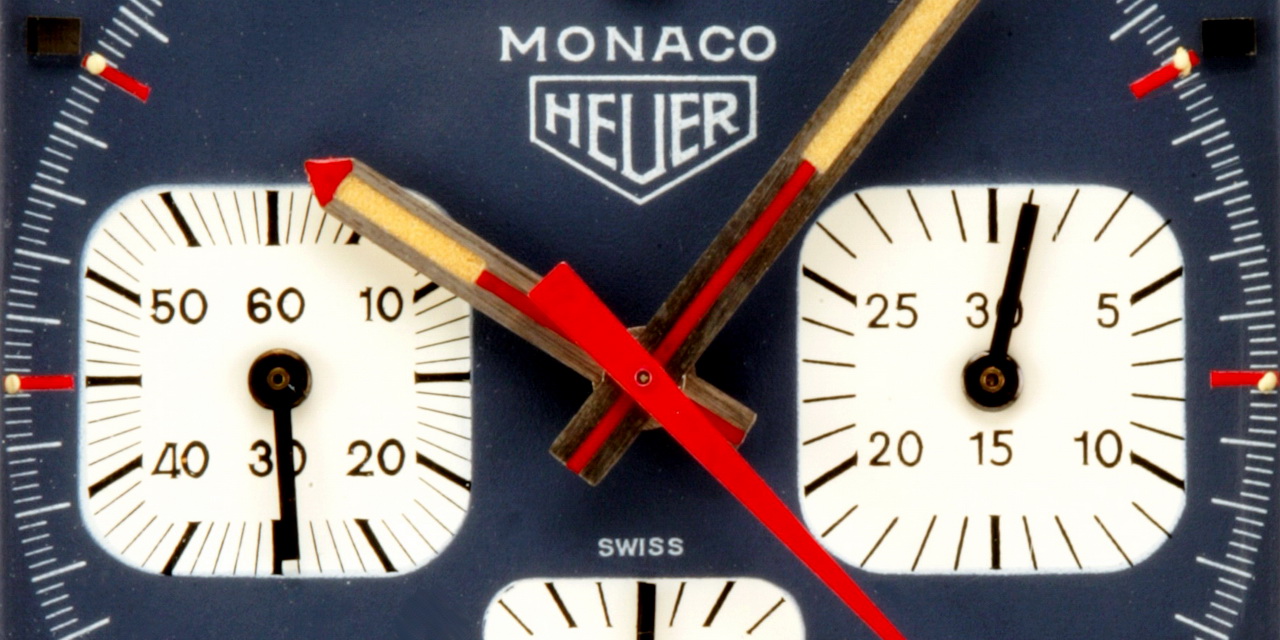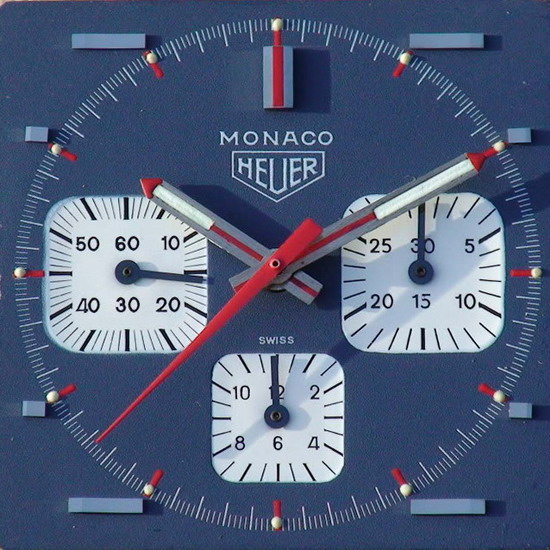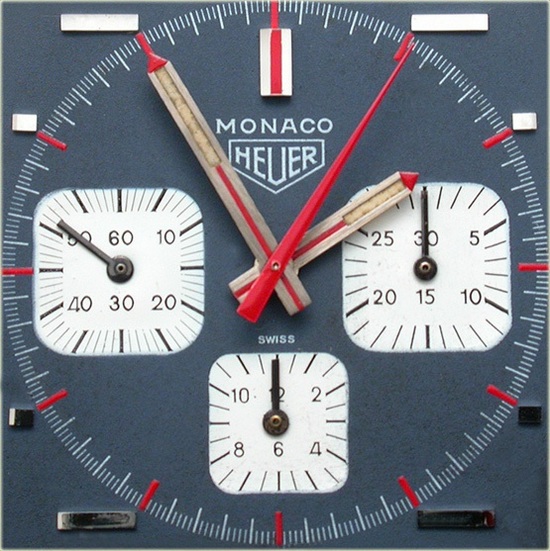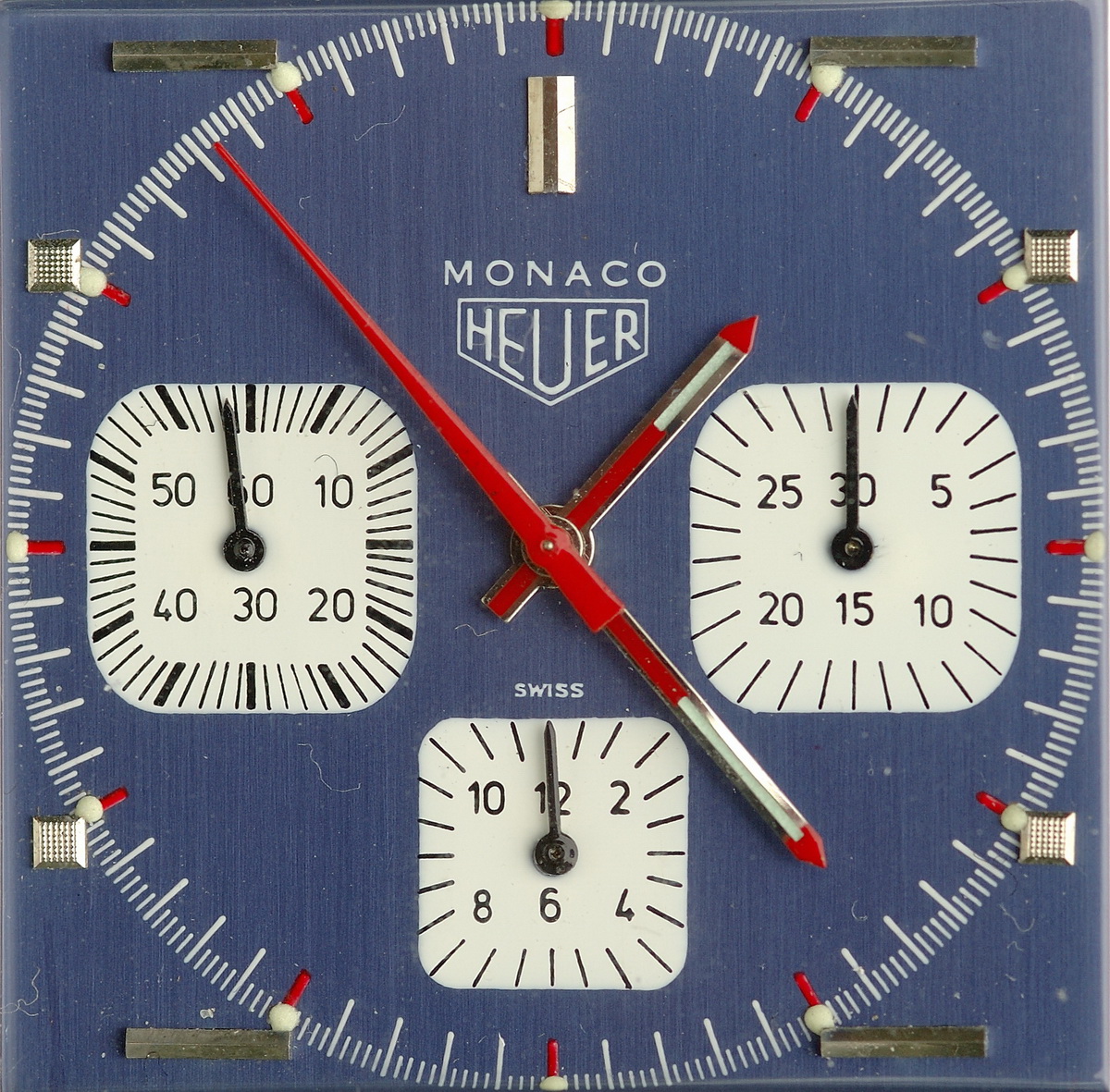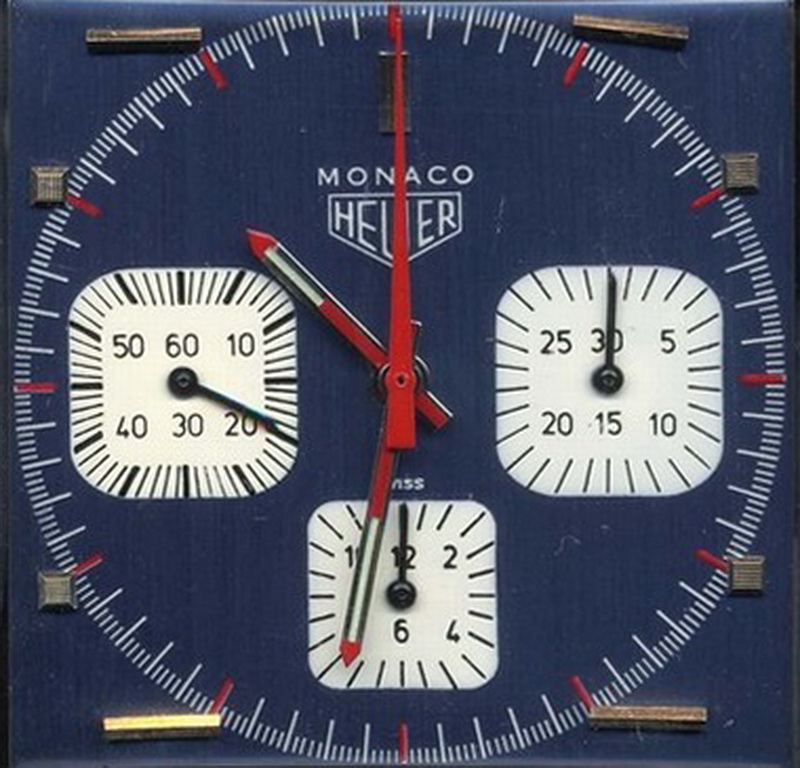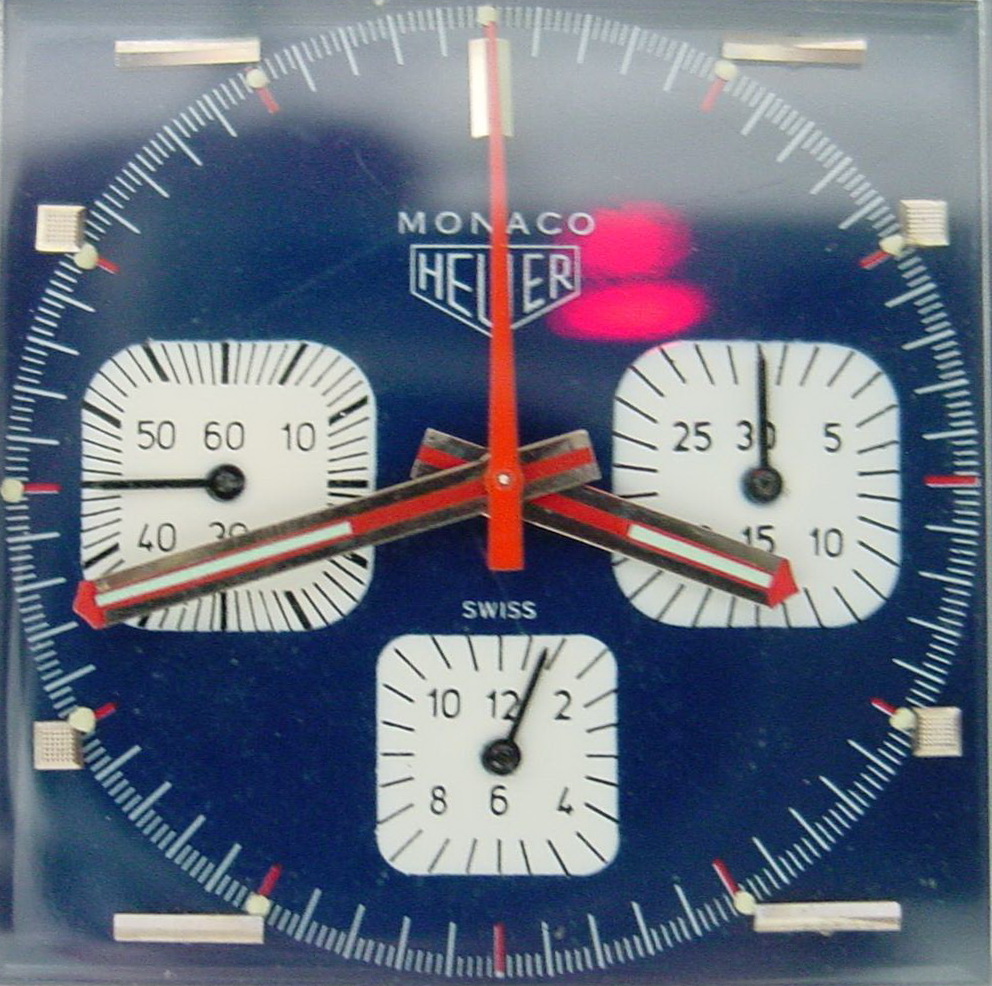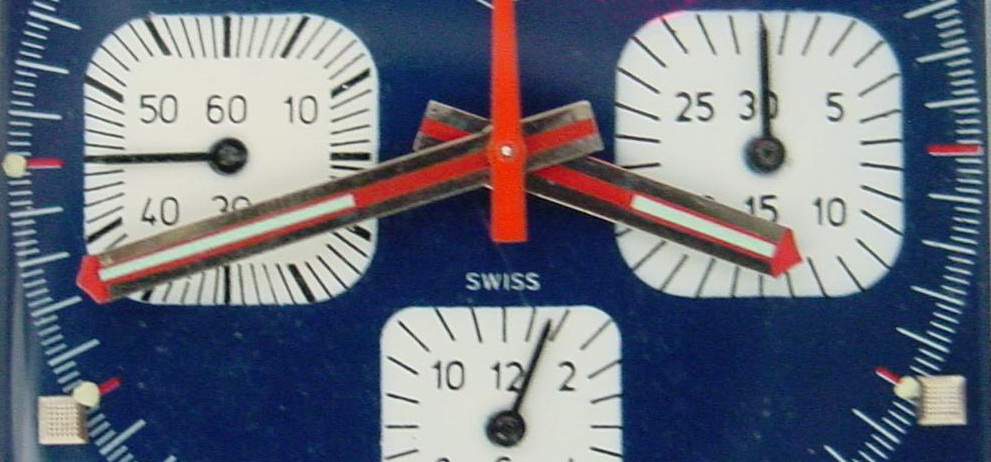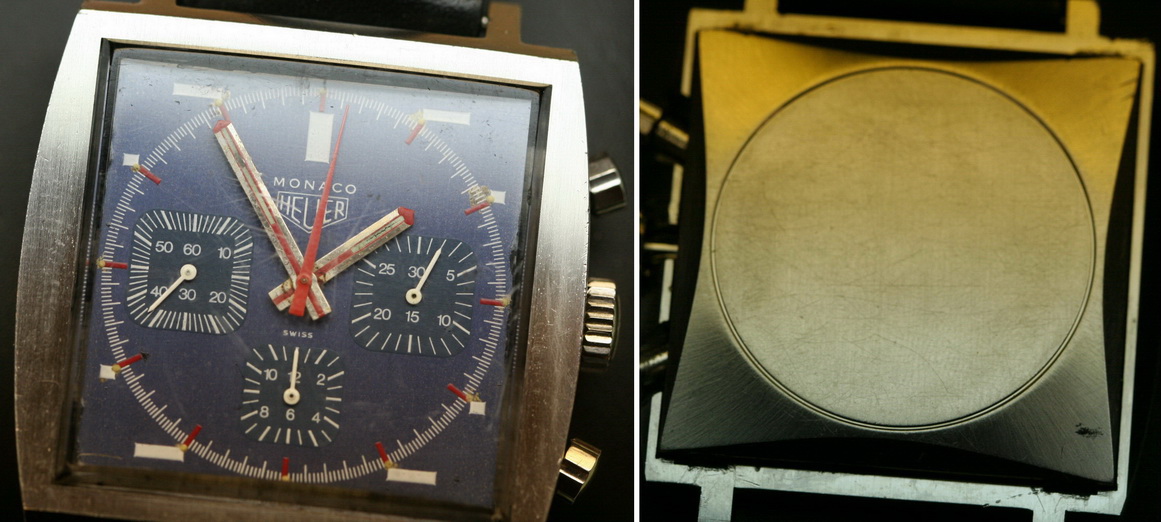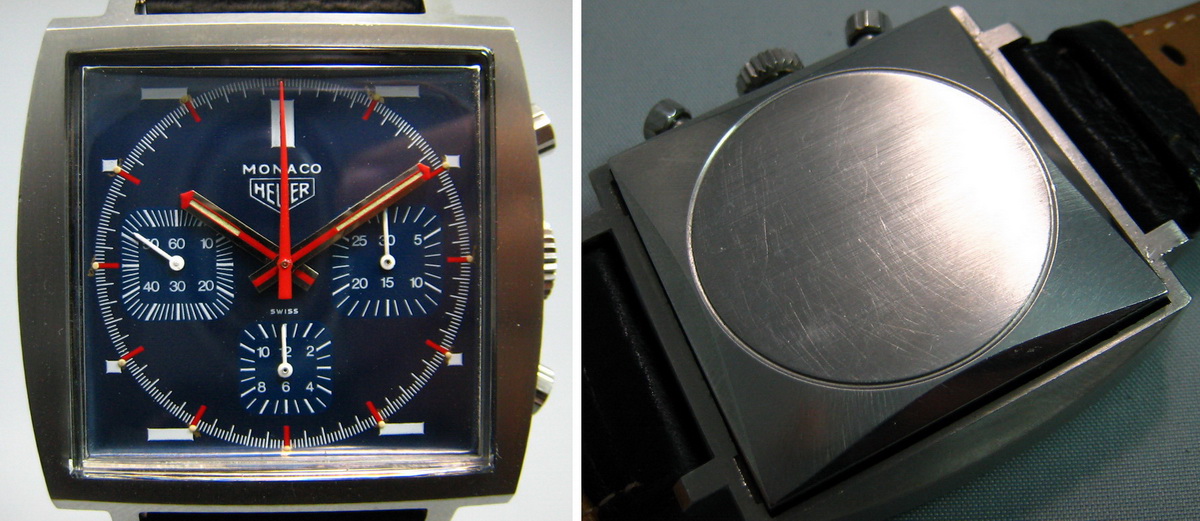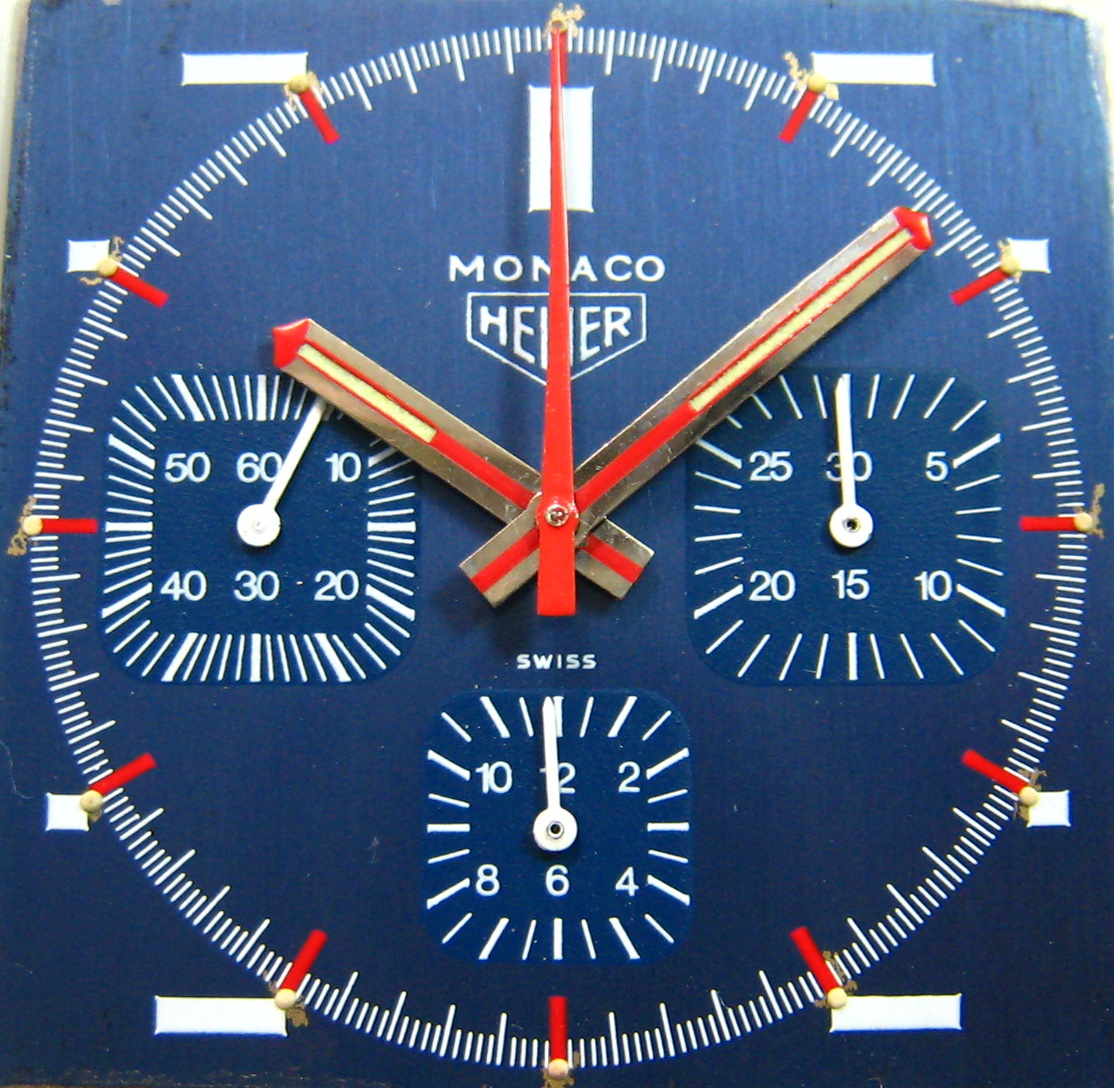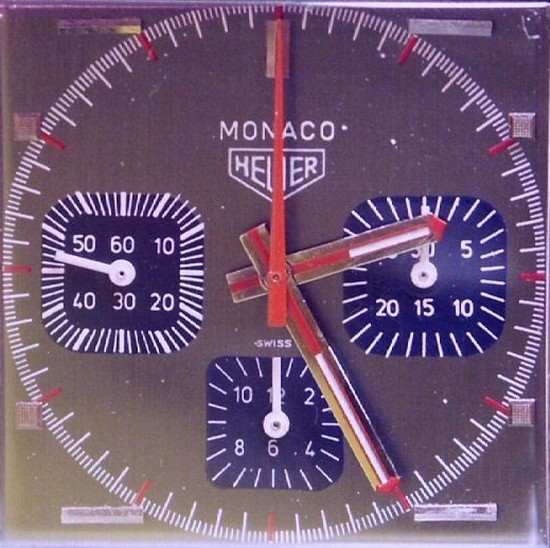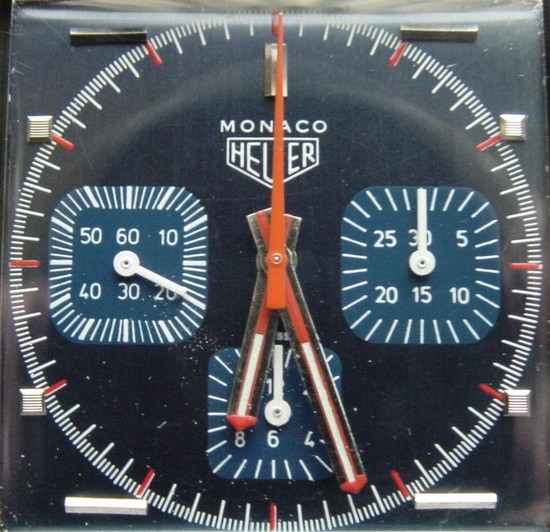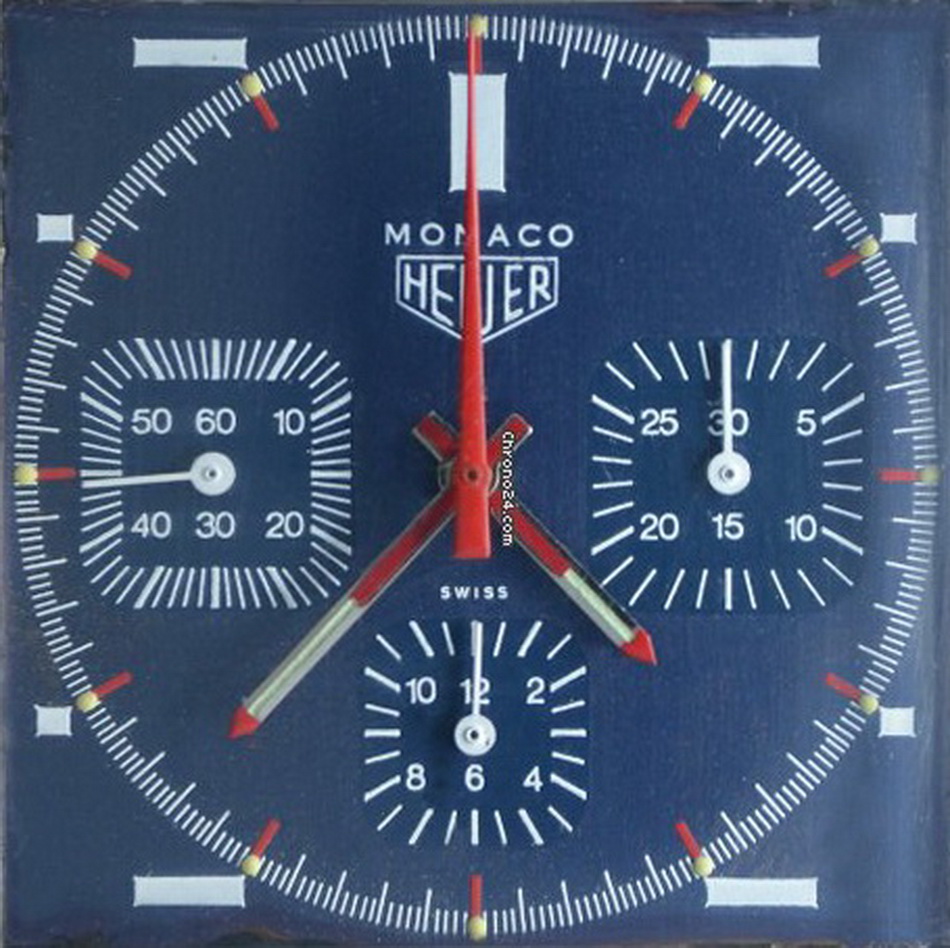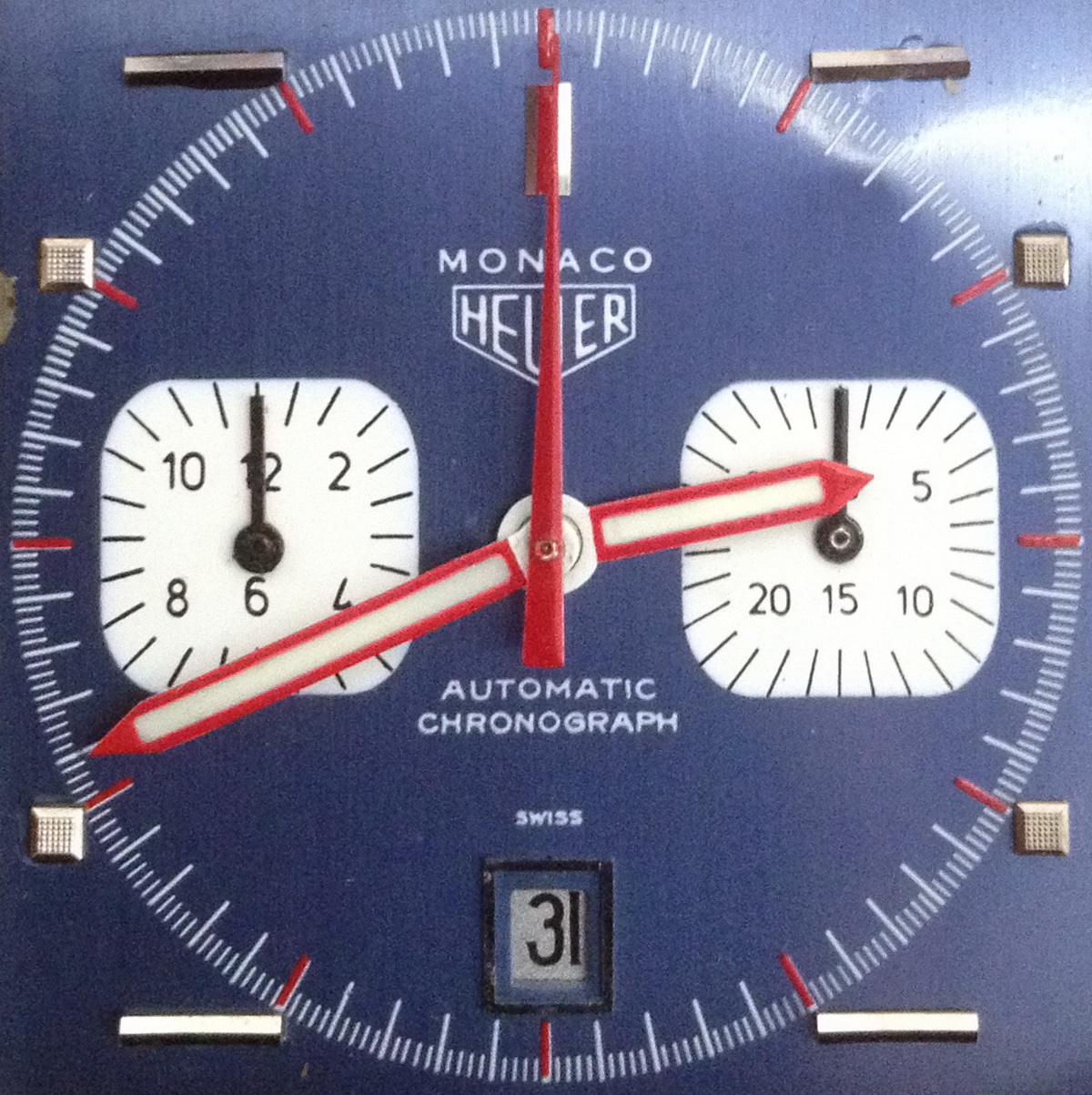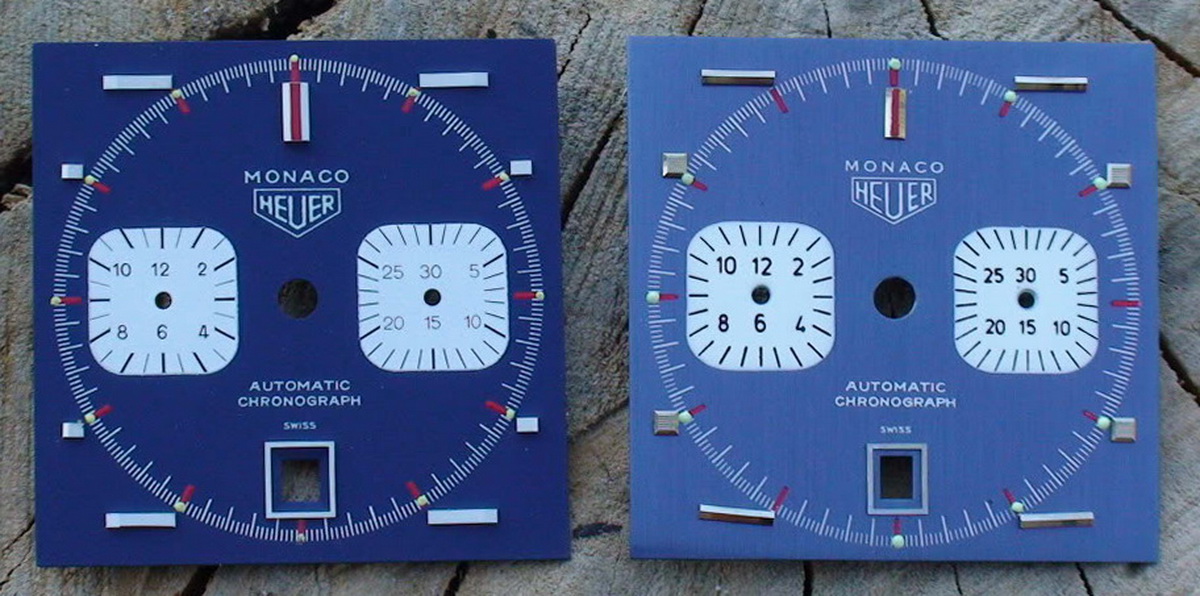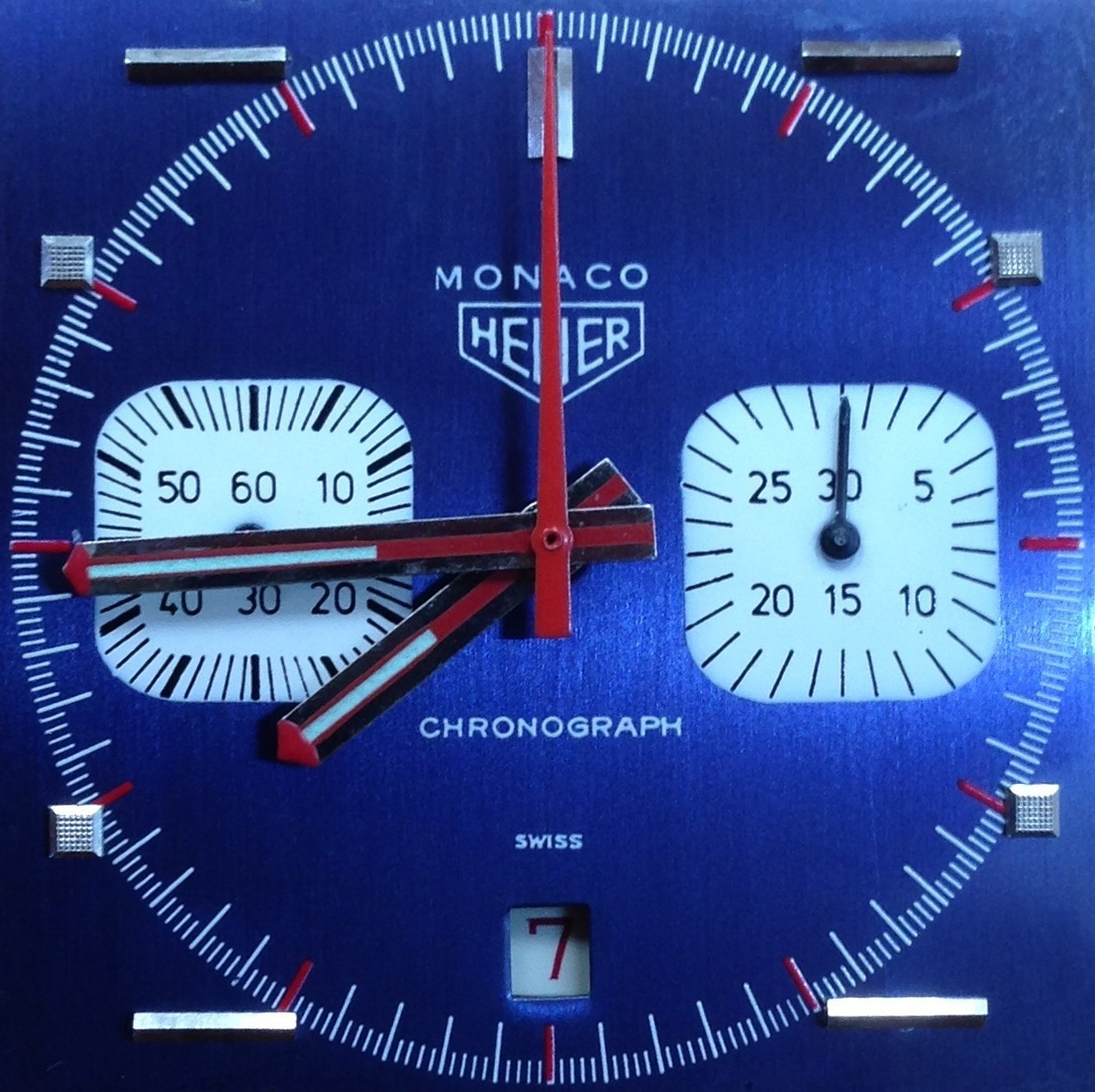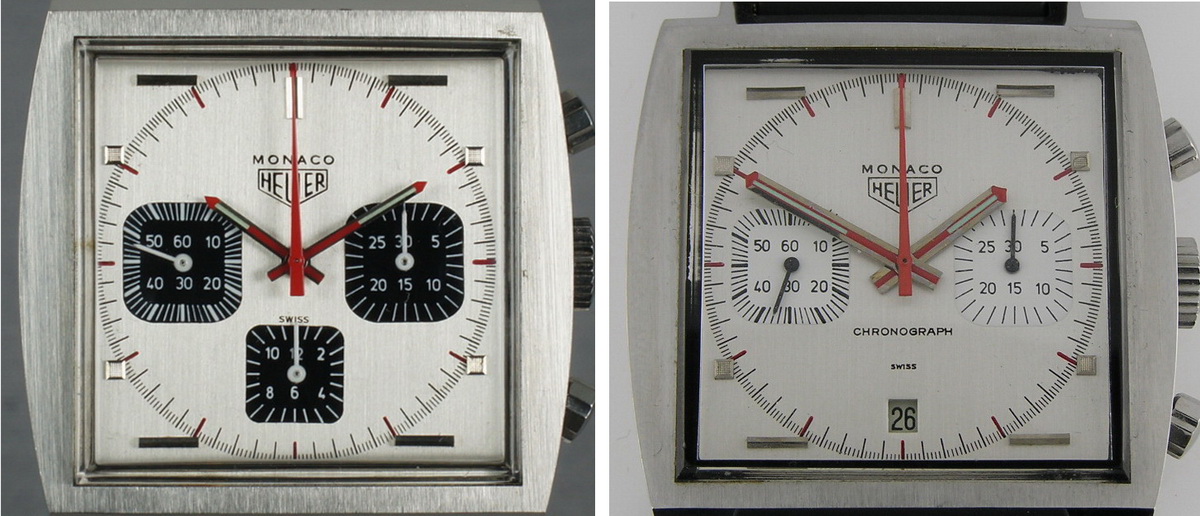Of all the vintage Heuer chronographs that we see, the Monaco Reference 73663 B (three register, manual wind Monaco, with a blue dial) may win the prize for being the model with the highest percentage of fakes, refinished dials, replacement hands and other issues of authenticity. In some instances, only one element has been replaced, while in others it is difficult to find any genuine Heuer components in the watch. It is difficult to arrive at a general rule for valuing the samples that have these issues, but it would be fair to suggest that the value of these troubled watches is typically less than one-half the value of an authentic one.
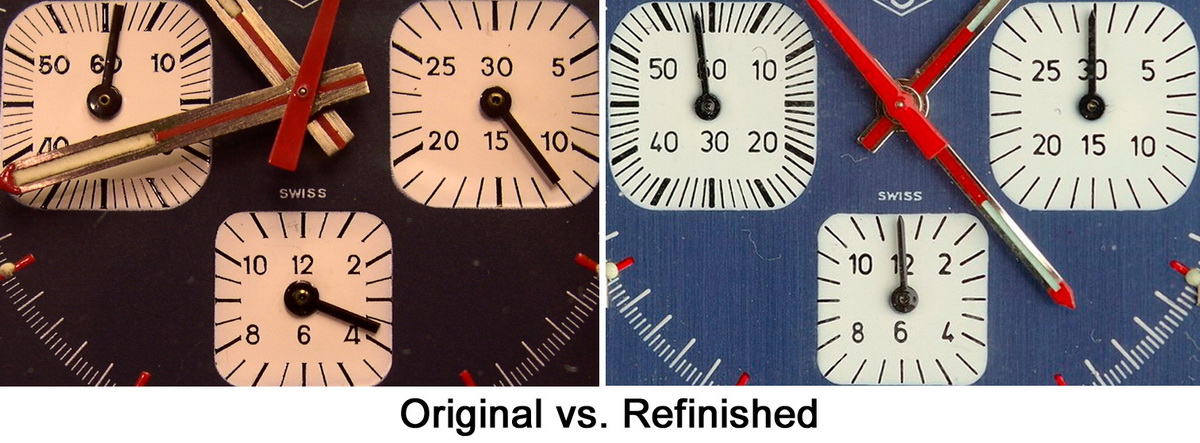
This posting focuses on the Monaco Reference 73663 B, because so many of them are fake and because the information that is useful in authenticating this model (or in spotting a fake) will be useful in evaluating other versions of the Monaco. Toward the end of this posting, we look at samples of other fake Monacos — a Caliber 12 automatic model and a two-register manual-wind model. No doubt, however, that the lessons learned on the Reference 73663 B will be useful in examining other models.
Overview — Spotting the Fakes / Refinished Dials
The three photos below provide an overview of some of the differences between a genuine Monaco (on the left and the right) and one with a poorly refinished dial and replacement hands (in the center). [Click on the image to see a high resolution version.] We will proceed to illustrate the most notable differences in further detail, below.
Key differences between the genuine and questionable samples of these Monacos include the following:
Hands — Hands on all versions of the Monaco shown in this posting are brushed steel, with luminous inserts, and the hands should be long enough to reach the circular track. Hands on some questionable samples are shorter, made of polished steel, and may not have luminous inserts.
Script — The letters in the “Heuer” shield and the word “Monaco” have considerable detail (for example, the “A” in the word Monaco and the “R” in the word Heuer should have small serifs / tails). Refinished / fake dials usually lack this fine detail.
Numerals and Hash Marks in the Registers — Just as there should be fine details in the “Heuer” and “Monaco” at the top of the dial, the three registers of an authentic Monaco should have fine detail, both in the numerals and the hash marks. Notice the different styles of the “4”s used in the original and refinished dials (open or closed), and variations in some other numbers. The hash marks on an original dial will also have different thicknesses, as well as serifs at the ends of some of the marks. The refinished dials usually lack these details.
Markers and dots — The Reference 73633B Monaco has applied markers made of polished steel. The markers at 2-4–8-10 are smaller and should be rectangular, with polished tops and one beveled edge (toward outside); the markers at 1-5-7-11 are much longer, but have the same basic geometry. On many of the refinished dials, we see that the smaller markers have “waffle” tops. Another telltale of a refinished dial is poor alignment of markers.
These Monaco dials had 12 luminous dots at the 5-10-15-20-etc. In many instances, the dial will be original, but these dots will have been replaced (relumed) or the dots may have been removed.
In some instances, the markers used on the refinished dial will bear no resemblance at all to the markers on the original Monaco dials, as shown below.
Case-Back — The case-backs of all genuine Monacos are marked with the Heuer shield and “Tool No. 033”, which refers to the plastic tool used to open the case.
Samples of Genuine Monacos (Reference 73633B)
The following four photographs show us the features of authentic three-register, manual-wind Monacos.
The sample below appears to be an entirely authentic sample, and is distinguished from many that we see on the market by the fact that it has its original lume on the dial and hands. Note the following elements of an authentic Heuer Monaco:
- proper detail in the script (“Heuer” and “Monaco”)
- brushed steel hands (long and wide, with luminous inserts)
- correct numerals and hash marks in the registers
- correct markers, properly positioned
The sample shown below also has an original dial and proper hands, but it appears that both the dial and the hands have been relumed. The watch would be considered authentic, although many collectors would impose some discount (say, 10%) because of the retouched dial and hands. The script and markings on the registers, as well as the applied markers, all appear to be original.
The sample shown below also has an original dial and hands, but it appears that the hands and dial have both been relumed. Script, registers and markers all appear to be correct.
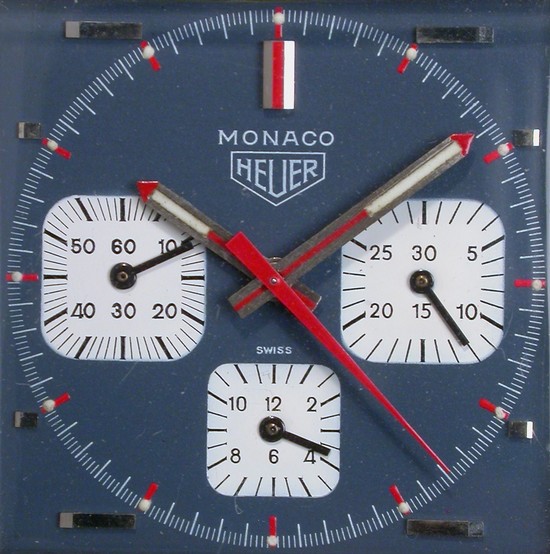
The sample shown below has an authentic dial, and the lume in the hands appears to be original. Note that there are no luminous dots on the dial; in many instances, luminous dots may fall off when the case is opened for servicing or they may have been removed. Script, registers and markers all appear to be correct.
Samples of Refinished Monacos
We see a lot of three-register manual wind Monacos with refinished dials, and a couple of factors might explain this. First, the Monacos asked a black rubber seal, between the dial and the top surface of the case. Over the years, many of these seals melted and damaged the paint on the dials. So many of the dials have been refinished. Second, Heuer made some look-alike Monacos for other brands (discussed below), and some of these dials may have been refinished to become Heuer dials.
The watch shown below has a refinished dial and the hands have been replaced. The following are the key elements that indicate that the dial has been refinished and the hands replaced:
- the “Heuer” shield and “Monaco” script are lacking in fine detail
- the dial has “waffle markers” at 2-4-8-10
- the hash marks on the chronograph registers are all the same weight; hash marks on the running seconds register (at nine o’clock) are crude / poorly finished
- the numerals on the registers are poorly formed; notice the open “4”s
- the hands are far too short, are too narrow, and do not have the brushed finish of the original hands.
The watch shown below has a refinished dial and replacement hands. It suffers from the same problems as the previous sample, and also from very poor positioning / alignment of the markers.
The watch shown below has a refinished dial and replacement hands. This style of hands, with the polished steel and blunt triangular tips, is very common on watches with refinished dials.
The close-up photo below provides a closer look at these hands, as well as many of the problems that we see on the refinished dials — waffle markers; open “4”s, and crude hash marks.
Monacos with Blue Registers
Over the years, one of the “great debates” in the community of vintage Heuer collectors relates to the authenticity of Reference 73633 Monacos, which have a blue dial and blue registers (which we will call “blue-on-blue”). This model never appeared in a Heuer catalog, and many of the samples that we have seen have telltale signs of refinished dials and replacement hands. We see several varieties of these blue-on-blue three register Monacos, some of which seem to have good quality in their details. First, we will look at some samples of the watches, then we will consider where they may have come from.
The sample below has some elements that look OK and others that look suspicious. At a glance, the detail on the registers looks good, including the closed “4”s. Suspicious elements include the blunt hands. Notice that rather than applied markers, most of these blue-on-blue Monacos have painted markers.
Our second sample has all the same elements as the first one, and the quality / finish appears to be acceptable, at least when viewed from a distance.
We take off the crystal, to have a closer look at the naked dial, and things are still looking OK.
It’s only when we go to the highest resolution photos that the problems become clear. The “Heuer” and “Monaco” script appear to be primitive, and the paint on the registers is very rough, compared with authentic samples. The hash marks in the registers also have a rough look.
We can look at a couple of additional samples that seem to have many of these same problems.
In terms of where all these blue-on-blue samples might have come from, we know that Heuer made watches that were very similar to the Reference 73633 Monaco for several other brands. Shown below are samples of watches that Heuer made for Diarex, which appear very similar to the three-register Monaco, Reference 73633. Notice that these watches have blue dials with blue registers, with the blunt tipped hands and painted markers. These are the same elements that we see on some of the questionanle blue-on-blue Monacos, which may suggest that these Diarex chronographs are the source for some of the blue-on-blue Monacos.
We know that Heuer made look-alike Monacos not only for Diarex, but also for other brands that included Bucherer, Edox and Villard. All the samples shown below have these same elements — closed “4”s, blunt hands and painted markers. We can assume that painted markers were less expensive than applied markers, which may explain the use of painted markers on these lower-priced brands. The case-backs on the watches for these other brands are not marked with the Heuer shield and “Tool No. 033”.
The TAG Heuer service department in Switzerland has authenticated the blue-on-blue Monaco shown below. Compared with the blue-on-blue Monaco shown above, we see the following:
- lines in registers are properly spaced and aligned
- markers are properly aligned
- numerals in the registers are correct script (notice the numeral “4”)
- luminous dots on the dial show some aging
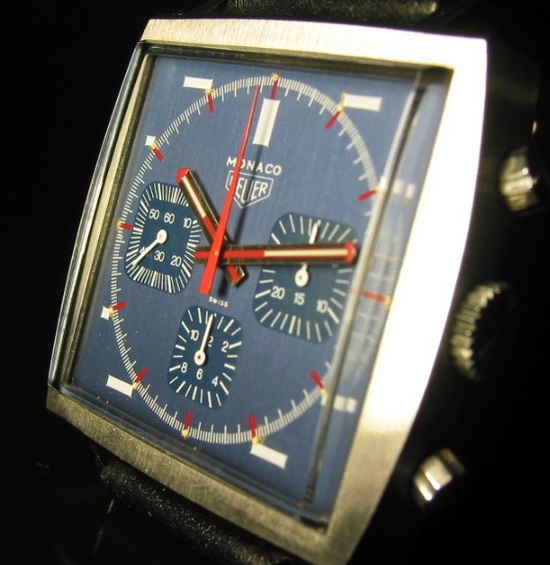
This sample also has the Heuer shield and the “Tool No. 033” marked on the case-back.
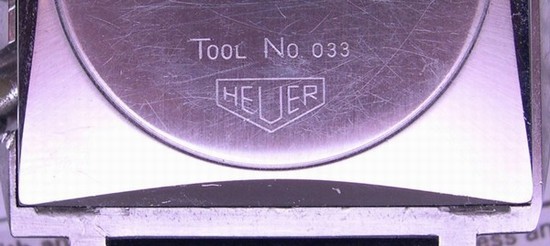
Shown below is another sample of a blue-on-blue Monaco, on which the dial seems to have a relatively high-quality finish. However, the script on “Heuer” and “Monaco” seems crude, the hands are far too short, and the case-back is not marked with the “Heuer” logo or “Tool No. 033”.
The Great Debate — Who Made All These Monacos?
Over the years, the community of vintage Heuer chronograph collectors has had several debates about the authenticity of the Monacos that appear to have refinished dials, as shown above. We have seen so many refinished dials, substantially all of them in the same two styles (white registers on blue dials and blue registers on blue dials), that it begs the question of where they all came from. The following are the most popular theories to explain the large number of these refinished dials.
- Theory: The Dials are Original. These versions of the Reference 73633 Monaco, white-on-blue (with waffle markers) or blue-on-blue (with painted markers), were produced by Heuer and used in original watches. They were either early versions (before the standard version) or late versions (as Heuer was attempting to develop a look that would be more popular). The style of the Heuer logo and script, and the hands, evolved over time. The poor quality of the white-on-blue dials leaves little doubt that they are fakes. With respect to the blue-on-blue version, TAG Heuer has authenticated at least one sample. Some of the blue-on-blue dials have some age on them; some seem to have a sophisticated finish. The following are among the key arguments against the authenticity of these dials:
- Heuer would not have issued dials of this poor quality. We do not see dials of such poor quality among any other Heuer models — Autavia, Carrera, etc.
- The serial numbers of the questionable samples do not support the theory that these dials were either an early or late variation; these dials seem to be evenly distributed among the full run of Reference 73633 Monacos
- TAG Heuer has not authenticated the white-on-blue version, and the authentication of the blue-on-blue version was an error.
- The age on some of the blue-on-blue dials does not confirm their authenticity; it only suggests that the refinishing was done many years ago
- An experienced watchmaker who was head of service department at Heuer US from the 1960s into the 2000s is certain that these dials were never used by Heuer, either as original dials or as service dials.
- Theory: The Dials and Hands are Service Parts. After Heuer produced its watches, it produced spare parts that were sent to its service centers to be used in the repair or restoration of watches. (These spare parts are usually called “service” parts, for example “service hands” or a “service crown.”) In most instances, the service parts are slightly different from the original parts, and today’s collectors are usually able to distinguish between the two types of parts. Under this theory, the white-on-blue Monacos with “waffle” markers and the blue-on-blue dials were service dials and the “blunt” hands were service hands. The arguments against this theory are as follows:
- While service parts may be slightly different from the original parts, they are usually of the same quality as the original parts. It is difficult to believe that Heuer would have used dials of such poor quality, even for service dials.
- If the “waffle” dials were service dials, we could expect to see some samples that would have had the dial replaced, but with the original hands remaining. The fact that we see these waffles dials with either the very short hands (that are obviously incorrect) or the “blunt” hands suggests that these were not simple service dials.
- Theory: The Dials are Fakes / Refinished. The third theory to explain the large quantity of refinished Monaco dials begins with a known Monaco problem — the black rubber seal that sits between the dial and the crystal often “melted”, doing considerable damage to the dial. In view of the demand for replacement dials, a dial refinisher produced a large quantity of dials, to replace the dials that were damaged by the melting black seals. The refinisher could have started with a stack of damaged dials, or even some dials that were made for the other brands (Edox, etc.), and he made a series of refinished dials that were then assembled into “Franken” watches, using a variety of cases, movements, hands, etc. The fact that some of the blue-on-blue dials show some age is easily explained — these refinished dials were made relatively early in the game, perhaps in the 1970s or 80s.
Some Other Refinished Monacos
While we see the highest percentage of refinished dials and put-together watches among the three-register, manual-wind Monacos (Reference 73633), many of the same telltales to detect refinished dials will be useful in spotting problems on other Monacos. While far from comprehensive, here are some representative samples of Monacos with refinished dials.
“Steve McQueen” Automatic Monaco. This McQueen Monaco exhibits most of the problems that we have identified with the three-register, manual-wind models — poorly placed “waffle” markers; lack of detail on the “Heuer” and “Monaco”, and poor quality on the registers (open “4”s and even weighting on the hash marks). The red-edged hands are service hands that were used by TAG Heuer.
And here’s another refinished dial for an automatic Monaco (below, right), shown next to an original dial.
Shown below is a Reference 74033 Monaco, one of the rarest of the vintage Heuers. It is hard to imagine that Heuer would have made many service dials for this one; rather, it must be a refinished dial, perhaps made from an original dial which had been damaged from a melting seal. Notice the telltales of a poorly refinished Monaco — low quality script and markings; poorly positioned waffle markers; no lume dots; and blunt style hands.
. . . and in the End
We bring this posting to a close with a couple of samples that demonstrate just about everything that can be wrong with a vintage Heuer Monaco — poor quality refinished dials, with replacement hands, and a paint color that is not even close to the dark gray / charcoal that Heuer used for the Monaco.
Additional References
The debate regarding the authenticity of the types of Reference 73633 B Monacos shown in this posting has occurred on a regular basis over the last 10 years. The following are messages on our discussion that will take you to these debates.
-
-
- Discussion in May 2004
- Discussion in May 2008, including some excellent side-by-side photos of original and refinished dials.
- Discussion in December 2009
-
Determining Authenticity?
I struggled with the title of this posting. According to my parlance, a vintage Heuer chronograph is “authentic” or “original” only if Heuer produced the watch and, 40 years after the fact, we are rarely able to be entirely certain that a watch was made by Heuer. Even a watch that appears to be entirely original could have been put together from parts, just last week, and most collectors would apply a discount to this “from original parts” watch. So, in the absence of a reliable witness who purchased the watch back in the 1970s, it is difficult to be certain that any vintage watch is entirely authentic or original.
As difficult as it may be to conclude that a vintage watch is authentic, however, it is often very easy to conclude that a vintage watch has problems, whether being a complete fake or one with a refinished dial, replacement hands or a case made for another brand. So while this posting may not enable today’s collector to actually authenticate a Monaco as being original, we have accomplished a lot if we have provided the information and images that allow the collector to avoid the obvious fakes. With this, we wish everyone “Happy Hunting!”, in the quest for the perfect, original, authentic, made-by-Heuer Monaco!!
Jeff Stein
September 16, 2014
Note — This posting was originally published in May 2004 as a guide to the authenticity of the Reference 73663 B Monacos, but has been revised to show additional samples of the Reference 73663 models, and also to add some additional models of the vintage Monaco.
